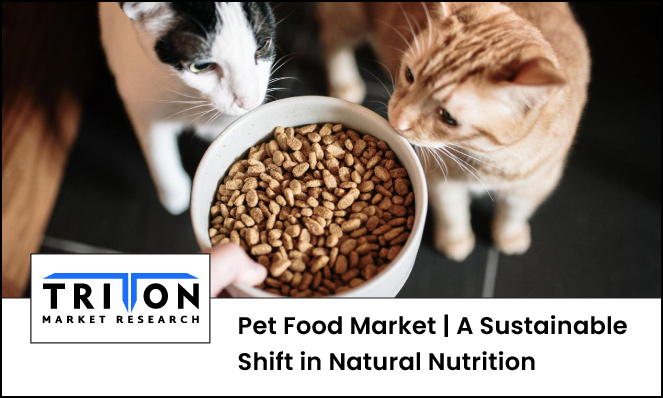



19, March 2024

Research from Mars Petcare reveals that around 57% of pet owners in the UK are open to switching to plant-based pet food. Thus, opportunities thrive for functional ingredients like proteins, vitamins, and prebiotics as health-benefiting premium foods. Emphasizing this uptrend, the Global Pet Food Market, analyzed by Triton Market Research, is forecasted to grow at a CAGR of 8.12% during the period 2024-2032.
Additionally, localized production facilities help counter sizable logistics costs and import barriers, given the emerging market demand. With global pet numbers set for a definite rise, the demand for pet food is inevitable. Hence, the market is witnessing a significant shift towards sustainability to reduce the environmental impact by avoiding animal-based pet food.
Explore in detail about this market in our FREE sample
While meeting advanced nutritional requirements, pet food also needs to reduce its environmental footprint for future sustainability. Various studies estimate that pet food products derived from conventional meat sources generate higher greenhouse gas emissions compared to alternate proteins.
As per the USDA study on pet food emissions, beef protein in dog food is associated with almost 50 times more production emissions than plant-based protein sources. Specifically looking at methane and CO2 emissions per kg of usable protein, beef clocks in at over 50 CO2-equivalent kg, poultry around 9 kg, whereas plant proteins like peas and corn range from just 0.3-1.7 kg.
Moreover, insects such as black soldier fly larvae record under 2 kg emissions, along with boasting feed conversion efficiency 10 times higher compared to cattle. Their pre-pupae stage composition profile matches chicken meals typically used in pet foods.
Additionally, Insect protein from black soldier fly larvae also gains strong traction as an environment-friendly alternative protein replicate of traditional meat. Thus, multiple startups and VC funds entered this arena recently, looking to commercialize greener pet food solutions.
Connect with our experts for a simplified analysis!
Expanding urbanization and nuclear families influence greater pet adoption. With pets considered as family, owners increasingly seek diets that reflect nutritional standards similar to humans. This awareness of health, taste, and a balanced pet diet fuels the growth of the studied market.
Plant-based nutrients sourced from origins like quinoa, chickpeas, peas, seaweed, and lentils supplemented with amino acid additions emerge as sustainable alternatives to regular meat diets. In this regard, Mars Petcare acquired Italian plant-based pet food maker Verso Food in July 2022 to augment its capabilities.
Nestlé Purina also accelerated new product development by 75% between 2020-2022, targeting veterinary and therapeutic segments. It innovated several pet food products to provide a combination of natural prebiotic fiber, high-quality ingredients, live probiotics, etc. Their products offer several benefits along with supporting digestive health and nourishing skin for cats and dogs, respectievly.
The leading pet food manufacturers are establishing localized production facilities within the developing world to target regional markets. High freight costs and substantial import duties levied earlier had posed significant barriers, capping accessibility of higher-priced imported pet foods.
Nestlé Purina provides a model case in point where 20% of its total global sales now come from developing and emerging geographic markets. It has a dedicated network of eight local pet food plants in Asia. It registered double-digit growth across Latin America and Eastern Europe markets, too.
With the global pet population estimated to surpass 1 billion by 2030, continued investments in localizing production and supply chains hold similar growth potential for established leaders and new entrants. Moreover, across regions like Asia-Pacific, Latin America and Eastern Europe, price-sensitive buyers prefer cost-effective products. Thus, local factories in these countries allow for affordably priced products catering specifically to regional volume market and middle-class demographic segments. This further enables customizing pet food options aligning with regional preferences.
Grab a Quick Read to Understand the Key Insights of the Pet Food Market
E-commerce is transforming the distribution landscape by offering convenience, a wider product selection, and direct-to-consumer sales channels for pet food manufacturers.
Q.2) What are the opportunities for innovation and sustainability in the global pet food market?Opportunities include developing eco-friendly packaging, introducing novel ingredients, leveraging advanced manufacturing technologies, and addressing pet-specific health concerns through innovative formulations.

Prevalent cases of terrorist attacks in today’s world is increasing the need for severe standards of security for public safety, and the global market for biometric technology scrupulously accommoda..
Prevalent cases of terrorist attacks in today’s world is increasing the need for..